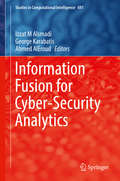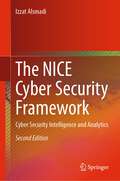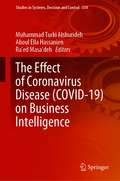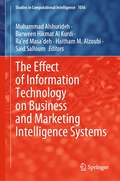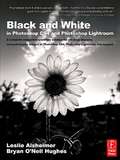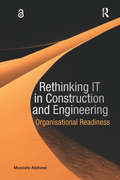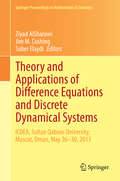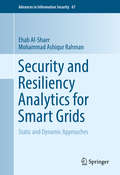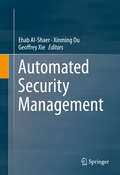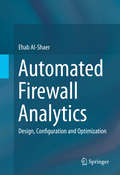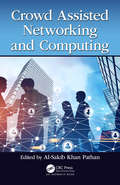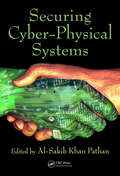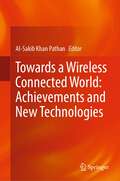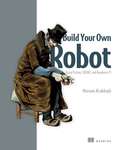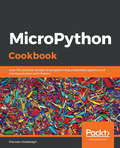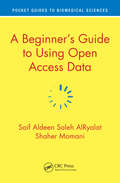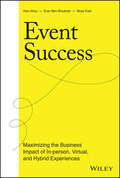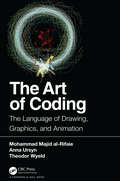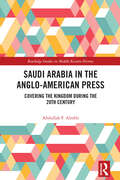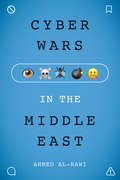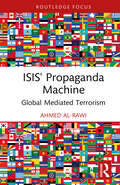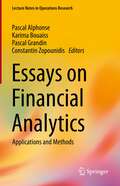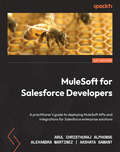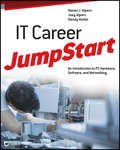- Table View
- List View
Information Fusion for Cyber-Security Analytics
by Izzat M. Alsmadi George Karabatis Ahmed AleroudThis book highlights several gaps that have not been addressed in existing cyber security research. It first discusses the recent attack prediction techniques that utilize one or more aspects of information to create attack prediction models. The second part is dedicated to new trends on information fusion and their applicability to cyber security; in particular, graph data analytics for cyber security, unwanted traffic detection and control based on trust management software defined networks, security in wireless sensor networks & their applications, and emerging trends in security system design using the concept of social behavioral biometric. The book guides the design of new commercialized tools that can be introduced to improve the accuracy of existing attack prediction models. Furthermore, the book advances the use of Knowledge-based Intrusion Detection Systems (IDS) to complement existing IDS technologies. It is aimed towards cyber security researchers.
The NICE Cyber Security Framework: Cyber Security Intelligence and Analytics
by Izzat AlsmadiThis updated textbook is for courses in cyber security education that follow the National Initiative for Cybersecurity Education (NICE) framework which adopts the Competency- Based Education (CBE) method. The book creates content based on the Knowledge, Skills and Abilities (a.k.a. KSAs) described in the NICE framework. This book focuses on cyber analytics and intelligence areas. The book has 18 chapters: Introduction, Acquisition Management, Continuity Planning and Disaster Recovery, Cyber Defense Analysis and Support, Cyber Intelligence, Cyber Intelligence Analysis, Cyber Operational Planning, Cyber Policy and Strategy Management, Cyber Threat Analysis, Cybersecurity Management, Forensics Analysis, Identity Management, Incident Response, Collection Operations, Computer Network Defense, Data Analysis, Threat Analysis and last chapter, Vulnerability Assessment.
The Effect of Coronavirus Disease (Studies in Systems, Decision and Control #334)
by Muhammad Turki Alshurideh Aboul Ella Hassanien Ra’ed Masa’dehThis book includes recent research works on how business around the world affected by the time of COVID-19 pandemic. The impact of recent technological developments has had a tremendous impact on how we manage disasters. These developments have changed how countries and governments collect information. The COVID-19 pandemic has forced online service companies to maintain and build relationships with consumers when their world turns. Businesses are now facing tension between generating sales during a period of severe economic hardship and respect for threats to life and livelihoods that have changed consumer preferences.
The Effect of Information Technology on Business and Marketing Intelligence Systems (Studies in Computational Intelligence #1056)
by Muhammad Alshurideh Barween Hikmat Al Kurdi Ra’ed Masa’deh Haitham M. Alzoubi Said SalloumBusiness shapes have been changed these days. Change is the main dominant fact that change the way of business operations running. Topics such as innovation, entrepreneurship, leadership, blockchain, mobile business, social media, e-learning, machine learning, and artificial intelligence become essential to be considered by each institution within the technology era. This book tries to give additional views on how technologies influence business and marketing operations for insuring successful institutions survival.The world needs to develop management and intelligent business scenario plans that suite a variety of crisis appears these days. Also, business and marketing intelligence should meet government priorities in individual countries and minimise the risk of business disruptions. Business intelligence - the strategies and technology companies that use it to collect, interpret, and benefit from data - play a key role in informing company strategies, functions, and efficiency. However, being essential to the success, many companies are not taking advantage of tools that can improve their business intelligence efforts. Information technology become a core stone in business. For example, the combination of machine learning and business intelligence can have a far-reaching impact on the insights the company gets from its available data to improve productivity, quality, customer service and more. This book is important because it introduces a large number of chapters that discussed the implications of different Information technology applications in business. This book contains a set of volumes which are: 1- Social Marketing and Social Media Applications, 2- Social Marketing and Social Media Applications, 3- Business and Data Analytics, 4- Corporate governance and performance, 5- Innovation, Entrepreneurship and leadership, 6- Knowledge management, 7- Machine learning, IOT, BIG DATA, Block Chain and AI, 8- Marketing Mix, Services and Branding.
Black and White in Photoshop CS4 and Photoshop Lightroom: A complete integrated workflow solution for creating stunning monochromatic images in Photoshop CS4, Photoshop Lightroom, and beyond
by Leslie Alsheimer Bryan O'Neil HughesIn the highly anticipated second edition of this groundbreaking book, NAPP GURU award recipient and professional photographer Leslie Alsheimer and Adobe's own Bryan O'Neil Hughes show you everything you need to know to uncover the secrets to successful black and white conversion and printmaking. This comprehensive reference will help you maximize your workflow with coverage of all of the relevant new features of Photoshop CS4 and Lightroom 2, including every stage of the black and white process from capture to printing. Along the way, you'll find in-depth explanations of key topics such as color management, optimizing your workspace, softproofing and calibration (both onscreen and for output), evaluating histograms, non-destructive editing, and much more. New features in this edition include:.In-depth coverage of workflow using the Bridge and Adobe Camera RAW components of CS4.New recipes and tips for advanced black and white conversion .Coverage of Lightroom and Photoshop integration features.An overview of scanners and scanning your black and white film.Advice on exposure essentials and how to apply the Zone System to your digital shooting .A brand new chapter on black and white and creative image editing in LightroomBreathtaking color and black and white photographs, including Leslie Alsheimer's image which won the coveted Vincent Versace award at Photoshop World in 2008, will inspire you to expand your own creativity to limitless possibilities. This is the essential resource for any photographer shooting black and white in the digital age.
Rethinking IT in Construction and Engineering: Organisational Readiness
by Mustafa AlshawiHow could the potential of IT be realised to improve business performance in architecture, construction and engineering organisations? How could organisations unleash the potential of IT to achieve a sustainable competitive advantage? How can organisations migrate from technology to IT-enabled business thinking? Based on the author's twenty years research experience, this book provides a holistic picture of the factors that enable architecture, construction and engineering organisations to explore the potential of IT to improve their businesses and achieve a sustainable competitive advantage. It raises awareness of the importance of the organisational 'soft issues' and the role they play in influencing the outcome of IT investments as well as addressing other complementary enablers, such as knowledge management, learning organisations, maturity models and e-readiness measurements. Real case studies are used throughout the book to illustrate various concepts and to provide the reader with a realistic and practical picture. Rethinking IT in Construction & Engineering is ideal for lecturers and researchers in architecture, construction and engineering as well as professionals at managerial level in industry.
Theory and Applications of Difference Equations and Discrete Dynamical Systems
by Ziyad Alsharawi Jim M. Cushing Saber ElaydiThis volume contains the proceedings of the 19th International Conference on Difference Equations and Applications, held at Sultan Qaboos University, Muscat, Oman in May 2013. The conference brought together experts and novices in the theory and applications of difference equations and discrete dynamical systems. The volume features papers in difference equations and discrete time dynamical systems with applications to mathematical sciences and, in particular, mathematical biology, ecology, and epidemiology. It includes four invited papers and eight contributed papers. Topics covered include: competitive exclusion through discrete time models, Benford solutions of linear difference equations, chaos and wild chaos in Lorenz-type systems, advances in periodic difference equations, the periodic decomposition problem, dynamic selection systems and replicator equations, and asymptotic equivalence of difference equations in Banach Space. This book will appeal to researchers, scientists, and educators who work in the fields of difference equations, discrete time dynamical systems and their applications.
Security and Resiliency Analytics for Smart Grids
by Ehab Al-Shaer Mohammad Ashiqur RahmanThis book targets the key concern of protecting critical infrastructures such as smart grids. It explains various static and dynamic security analysis techniques that can automatically verify smart grid security and resiliency and identify potential attacks in a proactive manner. This book includes three main sections. The first presents the idea of formally verifying the compliance of smart grid configurations with the security and resiliency guidelines. It provides a formal framework that verifies the compliance of the advanced metering infrastructure (AMI) configurations with the security and resiliency requirements, and generates remediation plans for potential security violations. The second section covers the formal verification of the security and resiliency of smart grid control systems by using a formal model to analyze attack evasions on state estimation, a core control module of the supervisory control system in smart grids. The model identifies attack vectors that can compromise state estimation. This section also covers risk mitigation techniques that synthesize proactive security plans that make such attacks infeasible. The last part of the book discusses the dynamic security analysis for smart grids. It shows that AMI behavior can be modeled using event logs collected at smart collectors, which in turn can be verified using the specification invariants generated from the configurations of the AMI devices. Although the focus of this book is smart grid security and resiliency, the included formal analytics are generic enough to be extended to other cyber-physical systems, especially those related to industrial control systems (ICS). Therefore, industry professionals and academic researchers will find this book an exceptional resource to learn theoretical and practical aspects of applying formal methods for the protection of critical infrastructures.
Automated Security Management
by Ehab Al-Shaer Xinming Ou Geoffrey XieIn this contributed volume, leading international researchers explore configuration modeling and checking, vulnerability and risk assessment, configuration analysis, and diagnostics and discovery. The authors equip readers to understand automated security management systems and techniques that increase overall network assurability and usability. These constantly changing networks defend against cyber attacks by integrating hundreds of security devices such as firewalls, IPSec gateways, IDS/IPS, authentication servers, authorization/RBAC servers, and crypto systems. Automated Security Management presents a number of topics in the area of configuration automation. Early in the book, the chapter authors introduce modeling and validation of configurations based on high-level requirements and discuss how to manage the security risk as a result of configuration settings of network systems. Later chapters delve into the concept of configuration analysis and why it is important in ensuring the security and functionality of a properly configured system. The book concludes with ways to identify problems when things go wrong and more. A wide range of theoretical and practical content make this volume valuable for researchers and professionals who work with network systems.
Automated Firewall Analytics: Design, Configuration and Optimization
by Ehab Al-ShaerThis book provides a comprehensive and in-depth study of automated firewall policy analysis for designing, configuring and managing distributed firewalls in large-scale enterpriser networks. It presents methodologies, techniques and tools for researchers as well as professionals to understand the challenges and improve the state-of-the-art of managing firewalls systematically in both research and application domains. Chapters explore set-theory, managing firewall configuration globally and consistently, access control list with encryption, and authentication such as IPSec policies. The author also reveals a high-level service-oriented firewall configuration language (called FLIP) and a methodology and framework for designing optimal distributed firewall architecture. The chapters illustrate the concepts, algorithms, implementations and case studies for each technique. Automated Firewall Analytics: Design, Configuration and Optimization is appropriate for researchers and professionals working with firewalls. Advanced-level students in computer science will find this material suitable as a secondary textbook or reference.
Crowd Assisted Networking and Computing
by Al-Sakib Khan PathanCrowd computing, crowdsourcing, crowd-associated network (CrAN), crowd-assisted sensing are some examples of crowd-based concepts that harness the power of people on the web or connected via web-like infrastructure to do tasks that are often difficult for individual users or computers to do alone. This creates many challenging issues like assessing reliability and correctness of crowd generated information, delivery of data and information via crowd, middleware for supporting crowdsourcing and crowd computing tasks, crowd associated networking and its security, Quality of Information (QoI) issues, etc. This book compiles the latest advances in the relevant fields.
Securing Cyber-Physical Systems
by Al-Sakib Khan PathanThink about someone taking control of your car while you're driving. Or, someone hacking into a drone and taking control. Both of these things have been done, and both are attacks against cyber-physical systems (CPS). Securing Cyber-Physical Systems explores the cybersecurity needed for CPS, with a focus on results of research and real-world deploy
Towards a Wireless Connected World: Achievements and New Technologies
by Al-Sakib Khan PathanThis book gathers key advances in various areas related to using wireless Internet and wireless connectivity to achieve a more connected world.The world is now highly dependent on Internet connectivity. Even though some parts of the globe remain isolated, the smoothly running world all around us relies on Internet services for countless businesses and activities. During the COVID-19 pandemic, we have seen that exclusively relying on wired Internet would leave out a large part of our tech-savvy world. Hence, wireless connectivity is essential to anywhere, anytime connectivity. Further, in the event of a new pandemic or other disaster of global scale, wireless Internet offers a reliable way to keep us all connected. The contributors to this book, hailing from academia, industrial and research laboratories, report on the latest solutions, trends and technologies with the potential to make wireless Internet more reliable and secure for the years to come.
Intelligent Cloud Computing
by Asma Al-Saidi Rudolf Fleischer Zakaria Maamar Omer F. RanaThis book constitutes the refereed post-conference proceedings of the First International Conference on Intelligent Cloud Computing, held in Muscat, Oman, in February 2014. The 10 revised full papers presented were carefully reviewed and selected from 18 submissions. The papers cover topics in the areas of resource management and energy efficiency and security. They include 5 invited talks from leading organizations working in cloud computing in Oman and in the region.
Build Your Own Robot: Using Python, CRICKIT, and Raspberry PI
by Marwan AlsabbaghA DIY guide to bringing your first robot to life with cheap and basic components.Build Your Own Robot introduces you to the exciting world of robotics in a way that&’s fun and affordable! You&’ll build your own real robot with easy-to-find hardware and free open source software. Plus, all the components you need can be assembled with simple tools like a screwdriver. In Build Your Own Robot you&’ll learn how to: Use cameras to capture photos and let your robot see Add cameras and basic computer vision Coordinate DC motors to move your robot Write a web app to control your robot Set up controls for joysticks Read QR codes to find and identify objects This book shows you how anyone can start building their own robot—no special soldering or electronic skills required. All you need is some basic Python know-how to get started. From scratch, you&’ll go hands-on with DC motors, touch sensors, custom shell scripting, joystick controls, and even face detection for your robot friend. About the technology You can build your own robot! With this book, you&’ll use readily-available hardware and author Marwan Alsabbagh&’s clear step-by-step instructions to create a robot that moves, manipulates objects, and responds to its environment. Along the way, you&’ll learn some serious skills like computer vision, networking, and the basics of robotics programming. About the book Build Your Own Robot is a project-based guide that takes you from spinning your first DC motor to programming a mobile robot that you can control from your phone or computer. You&’ll write simple Python code to help your new friend spin, move, and find its way. You&’ll even teach it to track faces and fetch snacks. Plus, a helpful hardware purchasing guide makes it easy to find exactly what you need to get started! What's inside Coordinate DC motors to move your robot Write a web app to control your robot Adding cameras and basic computer vision Read QR codes to find and identify objects About the reader Examples use simple Python code. No special skills or expensive tools required. About the author Marwan Alsabbagh is a seasoned software developer, who has studied mathematics and computer science at McGill University. The technical editor on this book was Alexander Ryker. Table of Contents 1 What is a robot? 2 Getting started 3 Driving the robot 4 Creating a robot shell 5 Controlling robots remotely 6 Creating robot web apps 7 Joystick-controlled robots 8 Keyboard-controlled camera 9 Face-following camera 10 Robotic QR code finder 11 Building a snack-pushing robot A Hardware purchasing guide B Configuring the Raspberry Pi C Robot assembly guide D Mocking the CRICKIT library
MicroPython Cookbook: Over 110 practical recipes for programming embedded systems and microcontrollers with Python
by Marwan AlsabbaghLearn how you can control LEDs, make music, and read sensor data using popular microcontrollers such as Adafruit Circuit Playground, ESP8266, and the BBC micro:bitKey FeaturesLoad and execute your first program with MicroPythonProgram an IoT device to retrieve weather data using a RESTful APIGet to grips with integrating hardware, programming, and networking concepts with MicroPythonBook DescriptionMicroPython is an open source implementation of Python 3 that runs in embedded environments. With MicroPython, you can write clean and simple Python code to control hardware instead of using complex low-level languages like C and C++. This book guides you through all the major applications of the MicroPython platform to build and program projects that use microcontrollers.The MicroPython book covers recipes that’ll help you experiment with the programming environment and hardware programmed in MicroPython. You’ll find tips and techniques for building a variety of objects and prototypes that can sense and respond to touch, sound, position, heat, and light. This book will take you through the uses of MicroPython with a variety of popular input devices and sensors. You’ll learn techniques for handling time delays and sensor readings, and apply advanced coding techniques to create complex projects. As you advance, you’ll get to deal with Internet of Things (IoT) devices and integration with other online web services. Furthermore, you'll also use MicroPython to make music with bananas and create portable multiplayer video games that incorporate sound and light animations into the game play.By the end of the book, you'll have mastered tips and tricks to troubleshoot your development problems and push your MicroPython project to the next level!What you will learnExecute code without any need for compiling or uploading using REPL (read-evaluate-print-loop)Program and control LED matrix and NeoPixel drivers to display patterns and colorsBuild projects that make use of light, temperature, and touch sensorsConfigure devices to create Wi-Fi access points and use network modules to scan and connect to existing networksUse Pulse Width Modulation to control DC motors and servosBuild an IoT device to display live weather data from the Internet at the touch of a buttonWho this book is forIf you want to build and program projects that use microcontrollers, this book will offer you dozens of recipes to guide you through all the major applications of the MicroPython platform. Although no knowledge of MicroPython or microcontrollers is expected, a general understanding of Python is necessary to get started with this book.
A Beginner’s Guide to Using Open Access Data (Pocket Guides to Biomedical Sciences)
by Saif Aldeen AlRyalat Shaher MomaniOpen Access Data is emerging as a source for cutting edge scholarship. This concise book provides guidance from generating a research idea to publishing results. Both young researchers and well-established scholars can use this book to upgrade their skills with respect to emerging data sources, analysis, and even post-publishing promotion. At the end of each chapter, a tutorial simulates a real example, allowing readers to apply what they learned about accessing open data, and analyzing this data to reach the results. This book can be of use by established researchers analyzing data, publishing, and actively promoting ongoing and research. Key selling features: Describes the steps, from A-Z, for doing open data research Includes interactive tutorials following each chapter Provides guidelines for readers so that they can use their own accessed open data Reviews recent software and websites promoting and enabling open data research Supplements websites which update recent open data sources
Event Success: Maximizing the Business Impact of In-person, Virtual, and Hybrid Experiences
by Alon Alroy Eran Ben-Shushan Boaz KatzMake events the most powerful marketing tool you have In Event Success: Maximizing the Business Impact of Physical, Virtual, and Hybrid Experiences, Alon Alroy, Eran Ben-Shushan, and Boaz Katz of Bizzabo draw on the knowledge they’ve gained powering events for companies like Amazon, Salesforce, and Uber to deliver an end-to-end playbook for readers wanting to maximize their organization’s return on events. Event Success will help you unlock the full potential of your events and make them your most important marketing channel. You’ll learn how to create elevated experiences in any format that drive strategic business goals, including: How to measure event success with surveys, data, analytics, and key KPIs How to integrate events into a strategic, end-to-end marketing plan How to collect, analyze, and funnel event data to other teams to drive business growth What events are successful, what the data says about them, and real-life examples from SAP, the Financial Times, IBM, and other leading brands that capture the imagination of their audiences through events Event Success is ideal for marketers, event professionals, and anyone responsible for creating buzz, driving new sales, and building thought leadership with in-person, hybrid, or virtual events. It’s also an invaluable resource for maximizing your organization’s “RoE”—or Return on Event—with measurable increases in sales.
The Art of Coding: The Language of Drawing, Graphics, and Animation
by Mohammad Majid al-Rifaie Anna Ursyn Theodor WyeldAs the title suggests, this book explores the concepts of drawing, graphics and animation in the context of coding. In this endeavour, in addition to initiating the process with some historical perspectives on programming languages, it prides itself by presenting complex concepts in an easy-to-understand fashion for students, artists, hobbyists as well as those interested in computer science, computer graphics, digital media, or interdisciplinary studies. Being able to code requires abstract thinking, mathematics skills, spatial ability, logical thinking, imagination, and creativity. All these abilities can be acquired with practice, and can be mastered by practical exposure to art, music, and literature. This book discusses art, poetry and other forms of writing while pondering difficult concepts in programming; it looks at how we use our senses in the process of learning computing and programming. Features: Introduces coding in a visual way Explores the elegance behind coding and the outcome Includes types of outcomes and options for coding Covers the transition from front-of-classroom instruction to the use of online-streamed video tutorials Encourages abstract and cognitive thinking, as well as creativity The Art of Coding contains a collection of learning projects for students, instructors and teachers to select specific themes from. Problems and projects are aimed at making the learning process entertaining, while also involving social exchange and sharing. This process allows for programming to become interdisciplinary, enabling projects to be co-developed by specialists from different backgrounds, enriching the value of coding and what it can achieve. The authors of this book hail from three different continents, and have several decades of combined experience in academia, education, science and visual arts. Source Code: The source code for the book can be accessed here.
Saudi Arabia in the Anglo-American Press: Covering the Kingdom during the 20th Century (Routledge Studies in Middle Eastern History)
by Abdullah F. AlrebhThis book provides an in-depth analysis of authority structures in Saudi Arabia during the twentieth century, as presented in two leading Western newspapers, The London Times and The New York Times. Beginning with a history of Saudi Arabia – from the building of the Kingdom in 1901, when Ibn Saud left his exile in Kuwait to recover Riyadh back from Al-Rasheed’s rule, until the death of King Fahd in 2005 – the author then outlines the theoretical framework of the book, specifically Weber’s original conception of authority. Weber’s notion of authority as having three types – traditional, charismatic, and rational-legal – is applied to an analysis of the two newspapers over the course of the twentieth century. A timeline is devised to aid this analysis, based on significant turning points in Saudi history, including Ibn Saud’s declaration of the Kingdom in 1932 and King Faisal’s assassination in 1975. Ultimately, this analysis discloses the many ways in which conceptions of authority in the Middle East were presented to Western audiences, whilst illuminating the political agendas inherent to this coverage in the UK and the US. This book is vital reading for anyone interested in Saudi Arabian history, Western perspectives of the Middle East, and the sociology of media.
Cyberwars in the Middle East (War Culture)
by Ahmed Al-RawiCyberwars in the Middle East argues that hacking is a form of online political disruption whose influence flows vertically in two directions (top-bottom or bottom-up) or horizontally. These hacking activities are performed along three political dimensions: international, regional, and local. Author Ahmed Al-Rawi argues that political hacking is an aggressive and militant form of public communication employed by tech-savvy individuals, regardless of their affiliations, in order to influence politics and policies. Kenneth Waltz’s structural realism theory is linked to this argument as it provides a relevant framework to explain why nation-states employ cyber tools against each other. On the one hand, nation-states as well as their affiliated hacking groups like cyber warriors employ hacking as offensive and defensive tools in connection to the cyber activity or inactivity of other nation-states, such as the role of Russian Trolls disseminating disinformation on social media during the US 2016 presidential election. This is regarded as a horizontal flow of political disruption. Sometimes, nation-states, like the UAE, Saudi Arabia, and Bahrain, use hacking and surveillance tactics as a vertical flow (top-bottom) form of online political disruption by targeting their own citizens due to their oppositional or activists’ political views. On the other hand, regular hackers who are often politically independent practice a form of bottom-top political disruption to address issues related to the internal politics of their respective nation-states such as the case of a number of Iraqi, Saudi, and Algerian hackers. In some cases, other hackers target ordinary citizens to express opposition to their political or ideological views which is regarded as a horizontal form of online political disruption. This book is the first of its kind to shine a light on many ways that governments and hackers are perpetrating cyber attacks in the Middle East and beyond, and to show the ripple effect of these attacks.
ISIS' Propaganda Machine: Global Mediated Terrorism
by Ahmed Al-RawiThis book examines ISIS’ media propaganda machine.The book focuses on case studies that have been largely understudied in relation to ISIS’ media production. Empirically, it offers new insights into how ISIS uses its media production to disseminate its extremist ideology by focusing on video games, educational apps, Dark Web sites, and offline billboards. The book argues that despite all the discussion about how ISIS has disappeared or even died, the terrorist group’s daily activities on the Dark Web show that they are still thriving and disseminating their propaganda in more than 20 different languages, and effectively functioning as an international news organization. Using a mixed-method research approach, the book offers a multilayered understanding of media content and fills a major gap in the literature, especially in relation to the use of educational apps and the Dark Web.This book will be of much interest to students of media and communication studies, terrorism and counterterrorism, Middle Eastern politics, and international relations.
Essays on Financial Analytics: Applications and Methods (Lecture Notes in Operations Research)
by Pascal Alphonse Karima Bouaiss Pascal Grandin Constantin ZopounidisThis book covers recent research advances, methods and techniques, applications and projects in financial analytics, with a focus on the effects of the health crisis on banking activities and financial engineering. It explores the latest developments in banking regulation, banking and financial systems, financial engineering, and corporate finance in order to provide financial analytics that assess financial stability and sustainability. Written for researchers and practitioners alike, the book is intended to promote stimulating scientific exchanges, ideas and experiences in the field of financial analytics for economics and management.
MuleSoft for Salesforce Developers: A practitioner's guide to deploying MuleSoft APIs and integrations for Salesforce enterprise solutions
by Arul Christhuraj Alphonse Alexandra Martinez Akshata SawantDesign, secure, test, and deploy APIs with MuleSoft, and integrate it with Salesforce to maximize productivityKey FeaturesBuild, implement, transform, secure, test, and deploy APIs using Anypoint Studio and Anypoint PlatformIntegrate MuleSoft with Salesforce and other end systems to build an application networkEnhance your Salesforce and MuleSoft skills and employability with interview and certification tips and tricksBook DescriptionMuleSoft for Salesforce Developers will help you build state-of-the-art enterprise solutions with flexible and scalable integration capabilities using MuleSoft's Anypoint Platform and Anypoint Studio. If you're a Salesforce developer looking to get started with this useful tool, look no further. This book will get you up to speed in no time, leveling up your integration developer skills. This essential guide will first introduce you to the fundamentals of MuleSoft and API-led connectivity, before walking you through the API life cycle and the Anypoint Studio IDE. Once you have the IDE set up, you'll be ready to create Mule applications. You'll look at the core components of MuleSoft and Anypoint Platform, and before long you'll know how to build, transform, secure, test, and deploy applications using the wide range of components available to you. Finally, you'll learn about using connectors to integrate MuleSoft with Salesforce and to fulfill a number of use cases, which will be covered in depth, along with interview and certification tips. By the end of this book, you will be confident building MuleSoft integrations at an enterprise scale and be able to gain the fundamental MuleSoft certification – MCD.What you will learnUnderstand how to use MuleSoft to achieve API-led connectivityDesign and create documentation for your APIDevelop Mule applications and run them in Anypoint StudioMonitor your applications from Anypoint PlatformTransform your data using DataWeaveUse the CI/CD and Mule Maven pluginsRun tests using MUnit and generate a code coverage reportUse best practices to maintain coding standardsWho this book is forThis book is for Salesforce developers who want to get started with MuleSoft. Salesforce architects will also find the concepts covered in the book useful in designing Salesforce solutions. Prior knowledge of any programming language and some basic integration concepts will be helpful, alongside basic familiarity with Salesforce development and experience with at least one Salesforce API – including the SOAP API, REST API, Bulk API, or Streaming API.
It Career JumpStart
by Naomi J. Alpern Joey Alpern Randy MuellerA practical approach for anyone looking to enter the IT workforce Before candidates can begin to prepare for any kind of certification, they need a basic understanding of the various hardware and software components used in a computer network. Aimed at aspiring IT professionals, this invaluable book strips down a network to its bare basics, and discusses this complex topic in a clear and concise manner so that IT beginners can confidently gain an understanding of fundamental IT concepts. In addition, a base knowledge has been established so that more advanced topics and technologies can be learned over time. Includes a discussion of the key computer components, such as the processor and memory Covers the basics of data storage as well as the input/output process Zeroes in on basic hardware configuration including how to install hardware and software drivers Introduces various computer operating systems, including the Windows OS family, Linux, and Mac. Looks at basic networking concepts and design IT Career JumpStart is an ideal starting point for anyone looking for a career in IT but doesn't know where to start.
